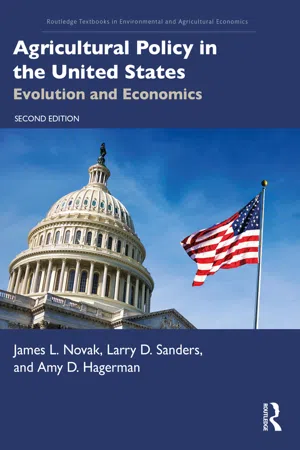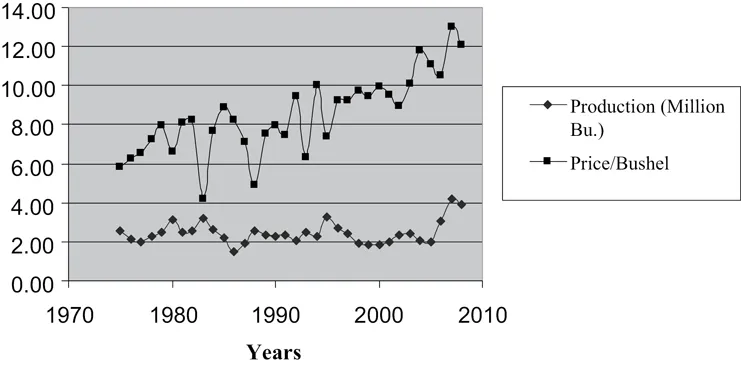
Agricultural Policy in the United States
Evolution and Economics
- 218 pages
- English
- ePUB (mobile friendly)
- Available on iOS & Android
Agricultural Policy in the United States
Evolution and Economics
About this book
Agricultural Policy in the United States: Evolution and Economics traces U.S. agricultural policy from its colonial roots to the present, using economic concepts to analyze and interpret political and economic consequences. It also examines the processes by which agricultural policies are developed, and the government structure which supports the implementation of legislation passed by Congress. The book includes arguments for and against common tools of U.S. agricultural policy, without influencing the reader in a particular direction. Each chapter contains questions and exercises to support students' learning, and technical economic material is contained in optional appendices. This second edition examines the Agriculture Improvement Act of 2018 and sets the scene for future policy developments. Additionally, it looks at trade wars and the impact of Black Swan events like the COVID-19 pandemic on agricultural resilience.
Frequently asked questions
- Essential is ideal for learners and professionals who enjoy exploring a wide range of subjects. Access the Essential Library with 800,000+ trusted titles and best-sellers across business, personal growth, and the humanities. Includes unlimited reading time and Standard Read Aloud voice.
- Complete: Perfect for advanced learners and researchers needing full, unrestricted access. Unlock 1.4M+ books across hundreds of subjects, including academic and specialized titles. The Complete Plan also includes advanced features like Premium Read Aloud and Research Assistant.
Please note we cannot support devices running on iOS 13 and Android 7 or earlier. Learn more about using the app.
Information
1IntroductionWhat Is Agricultural Policy and Why Does It Exist?
What is Agricultural Policy?
Why Does Agricultural Policy Exist?
Market Failure

Arguments Presented for U.S. Agricultural Policy
- There are economic inefficiencies unique to agriculture which cannot be, or will not be, corrected by the market.
- Agriculture is increasingly globalized, requiring government’s policing of imported food and maintenance of a domestic food supply.
- Technology change has caused shifts in supply and volatility in farm income which require the government to stabilize.
- Environmental protection of wildlife, land, and water is necessary by the government because the agricultural market does not currently value them.
- Agricultural risks mitigation by private sector insurance is a failure of the market.
- Politics.
- Unequal market power between farmers and processors and attempts at monopolization have necessitated government regulation.
- Farm family poverty is reduced through the provision of price and income supports.
- Foreign governments attempt to enhance their economic advantage through subsidizing their farmers to the disadvantage of U.S. farmers.
- Production of surplus commodities through subsidizing U.S. farmers ensures a cheap food supply for the populace, keeping them well fed and happy.
- Rural infrastructure development is expensive and often not worth doing by the private sector. The government is needed to take on this task.
- Small farmers benefit from agricultural policies which keep them in business. A nation of small and independent farmers enhances the goal of a free market.3
Arguments Presented against Having a U.S. Agricultural Policy
- U.S. subsidies to agriculture cause surplus production which is dumped on world markets, hurting poor Third World farmers.
- Large farmers get the majority of the farm program support payments and they don’t need them because they are rich.
- The U.S. has large budget deficits to take care of and can no longer afford agricultural subsidy programs.
- Farm bills favor the production of unhealthy commodities (foods such as corn syrup) to the detriment of healthy foods (like green vegetables).
- Commodity support programs keep inefficient farm units in business.
- Landlords (landowners) benefit from government-provided subsidies more than do farmer land renters.
- Without policy the farm economy would be hurt but would recover in 3–5 years with higher prices.
- U.S. taxpayers subsidize U.S. farmers, which reduces their income. By eliminating farm subsidies, taxpayers would bene...
Table of contents
- Cover
- Half-Title Page
- Series Page
- Title Page
- Copyright Page
- Table of Contents
- Preface
- Acknowledgment
- 1 Introduction: What Is Agricultural Policy and Why Does It Exist?
- 2 Economic Concepts Applied to Agricultural and Food Policy
- 3 Who Makes Agricultural Policy and How Is It Made?
- 4 A Brief History and the Evolution of Agricultural Policy
- 5 Early Twentieth-Century Agricultural Legislation
- 6 McNary-Haugen and the Permanent Legislation to the 1950s
- 7 The 1960s to Mid-1980sTransition and Farm Crises
- 8 Planting Flexibility and Direct Payments, 1985–1996
- 9 Twenty-First-Century Agricultural Legislation
- 10 International Trade: Is It the Future of U.S. Agricultural Policy?
- 11 Agricultural Policy Since 2014
- 12 The Future of Agricultural Policy: A Policy Shift to Risk Management
- Index